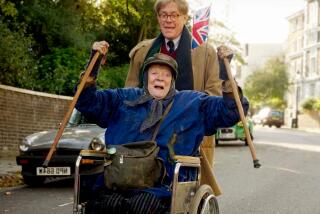Agnes de Mille En Pointe : PORTRAIT GALLERY <i> by Agnes de Mille (Houghton Mifflin: $19.95; 305 pp.; 0-395-52809-7)</i>
- Share via
At PBS they titled her recent TV documentary “Agnes, the Indomitable de Mille”--a supreme case of truth in advertising.
The feisty iconoclast who elbowed her way into the rarefied, male-dominated society of ballet choreographers four decades ago helped revolutionize the Broadway musical by integrating story into dance, and held forth in her art form as social commentator nonpareil, even beat back the adversity of a stroke suffered in 1974.
Any ordinary mortal might have lacked the courage or determination to relearn speech and movement, as she did, but the niece of Cecil B. De Mille was always a fighter, an outspoken and irreverent one at that. Happily, little has changed for the octogenarian in that regard.
A pioneer in American dance, she went on to chronicle her recovery in a book (“Reprieve”) and followed one amazing feat with another. From a wheelchair, De Mille created “The Informer,” a major new work for the 1988 season of American Ballet Theatre--the company she had endowed early on with such national classics as “Rodeo” and “Fall River Legend.”
Now, crippled with arthritis and nearly bedfast, the indomitable one still has something more to herald: this, her 12th book.
“Portrait Gallery,” a collection of monographs, is about celebrated figures De Mille has known, as well as noted family members. With the keenest appreciation of Isadora Duncan, for instance, and a palpable dislike for Sol Hurok, her most incisive profile of the lot, the writer offers lively, literate glimpses into the world of dance and show business.
Mostly she dotes on her own encounters with these subjects, using the same autobiographical style as before. Otherwise, she lends the occasional perspective from afar, capturing the particular dancer’s poetic essence, but more often, and sometimes unfairly, puncturing any myth of benevolence that person may have enjoyed.
There were three figures, she admits, who positively astonished her: Antony Tudor, Sybil Shearer and Carmelita Maracci. Only the first (about whom she has written in previous books and thus omits here) is widely known among dance audiences; for whatever reason, she doesn’t deliver an entry on the second. But her account of the late Maracci, easily the most extraordinary dancer to languish in oblivion, is fascinating.
She relies on her diary of half a century ago for the exquisitely detailed descriptions of this phenomenal concert dancer-turned-teacher-turned-recluse, but perhaps because of their love-hate relationship and De Mille’s likely envy of Maracci’s gifts, she fails to put her in historical view.
The two became friends in Los Angeles during the late 1930s when De Mille attended Maracci’s ballet classes, which were that rare thing: a true art form, as opposed to a regimental skill. Her vignette of Carmelita in the studio--winking at the regulars while a flabbergasted visitor, Anton Dolin, watched Maracci knock off a smart series of entrechats six interspersed with entrechats huit-- is choice. It also provokes frustration in the reader who never saw such marvels firsthand.
However, her explanations of this complex person fall short. She notes that “Carmie” destroyed what promised to be a monumental career (the New York Times’ John Martin proclaimed her “a genius” in six-column notices), owing to “a fugue of neuroses.” She even intimates that a terror of failure paralyzed the dancer who canceled more performances than she gave.
But when De Mille tells how she marched into Maracci’s dressing room, cavalierly denouncing her friend’s Ballet Theatre debut the way one scolds an errant cheerleader, the chronicler shows an insensitivity that borders on cruel: Maracci was so devastated by the verdict that she had to be carried from the theater.
In Maracci’s brilliant letters, which De Mille quotes, the fugitive from the stage tried to explain to her friend why some people cannot be practical-minded enough to work within the system: “I was a rotten soldier, Agnes, and it is you who want people to be good ones.”
But De Mille denies ever making such appeals to her troubled friend, even while offering contradictory evidence right in the text: “I am more of an anarchist than ever,” wrote Maracci. “I could never have danced as I did had I been an obedient servant.”
The above picture is a comparatively tempered one, perhaps owing to De Mille’s compassion or sense of superiority over Maracci, at least in the way of worldly success. Overpowering the competition has a way of engendering charity.
In the author’s swipes at showman Billy Rose and her one-sided view of a weepingly puerile Alicia Markova, one can only be reminded that, at 81, De Mille may be looking to settle a few personal scores.
In the case of Sol Hurok, however, the author’s pity for the subject somewhat neutralizes her animus. Perhaps because she knew that he was not universally liked or because she got to see his loneliness up close (as the wife of Hurok’s aide-de-camp, Walter Prude, De Mille was on intimate terms with the definitive impresario), she rails against him less bitterly.
So much for peer review. But when De Mille reminisces on her girlhood, a wholly different voice materializes: that of the dutiful daughter, even now still idealizing her parents. In quaint Victorian prose she refers to “Mother” and uses such phraseology as “Oh, pshaw” and “Father sired an illegitimate child.”
Unwittingly, Agnes de Mille reveals much about herself, and the picture is not always flattering. But she offers a provocative point of view for the reader equipped to discount her blind prejudices and episodes of defamation.
When she is good, she is very, very good, and when she is bad she is just mean-spirited.
More to Read
The biggest entertainment stories
Get our big stories about Hollywood, film, television, music, arts, culture and more right in your inbox as soon as they publish.
You may occasionally receive promotional content from the Los Angeles Times.










